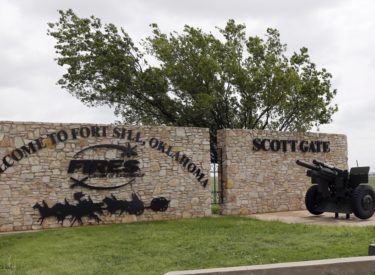Japanese Americans, detained as kids, plan Fort Sill protest
The Associated Press - June 22, 2019 10:23 am

This June 17, 2014 file photo shows an entrance to Fort Sill near Lawton, Okla. The federal government has chosen the military base in Oklahoma as the location for a new temporary shelter to house migrant children and is considering a customs port in southern New Mexico as another option, as existing shelters are overwhelmed. The Office of Refugee Resettlement said Tuesday, June 11, 2019 it's dealing with a dramatic spike in the number of children crossing the border without parents. (AP Photo/Sue Ogrocki, File)
LAWTON, Okla. (AP) – Demonstrators including Japanese Americans who were detained as children by the U.S. government during World War II are speaking out against the current administration’s plans to house migrant children, who have been separated from their families, at an Oklahoma Army base.
Groups including the Japanese American National Museum and Densho, which documents the history of Japanese American incarceration, plan to protest Saturday outside Fort Sill near Lawton, OK. They also will hang origami paper cranes in an effort to inspire hope for the migrant children.
The federal Office of Refugee Resettlement said this month that it plans to temporarily place up to 1,400 kids at the base. Fort Sill also housed migrant children in 2014 under the previous administration.
Concerns have been raised about the quality of living conditions diminishing under the current administration, particularly at facilities in Clint, Texas and in McAllen, Texas. Administration officials went before a Ninth Circuit panel on Tuesday and attempted to defend the position that access to soap, bedding, clean clothes, and toothbrushes were not part of its responsibility to provide “safe and sanitary” conditions, as specified by the Trafficking Victims Protection Reauthorization Act of 2008, which was signed by former President George W. Bush. The standard of living has been reported to be lower than the average American prison, in some instances only providing children with one meal and one glass of water each day, while facilities across the country reportedly manage to turn profits as high as $700 per day.
Fort Sill was also used to incarcerate hundreds of the approximately 120,000 Japanese and Japanese American people that the federal government detained during the war with Japan.



